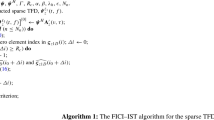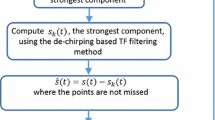Abstract
This paper focuses on the high resolution time-frequency distribution (TFD) of multicomponent signals with amplitude and frequency modulations, and a concise method named short-time sparse representation (STSR) is proposed. In STSR, both analysis and synthesis of the discrete signal can be achieved by exploiting the signal’s sparsity in frequency domain at each time instant. In order to fasten the STSR procedure, an efficient sparse recovery algorithm named SL0 is applied, and the signal model for each sliding window is modified to form the same dictionary, which guarantees that the whole recovery procedure adapts to the matrix form. The performance of STSR is compared with other TFD techniques and assessed in various configurations. It is shown that both preferable representation and acceptable computational cost can be obtained.






Similar content being viewed by others
References
C.D. Austin, R.L. Moses, J.N. Ash, E. Ertin, On the relation between sparse reconstruction and parameter estimation with model order selection. IEEE J. Sel. Top. Signal Process. 4(3), 560–570 (2010)
M. Babaie-Zadeh, C. Jutten, On the stable recovery of the sparsest overcomplete representations in presence of noise. IEEE Trans. Signal Process. 58(10), 5396–5400 (2010)
B. Boashash, P. O Shea, Polynomial Wigner-Ville distributions and their relationship to time-varying higher order spectra. IEEE Trans. Signal Process. 42(1), 216–220 (1994)
P. Borgnat, P. Flandrin. Time-frequency localization from sparsity constraints, in IEEE International Conference on Acoustics, Speech, and Signal Processing. (ICASSP08), (2008)
A.M. Bruckstein, D.L. Donoho, M. Elad, From sparse solutions of systems of equations to sparse modeling of signals and images. SIAM Rev. 51(1), 34–81 (2009)
A. Bultan, A four-parameter atomic decomposition of chirplets. IEEE Trans. Signal Process. 47, 731–745 (1999)
S.S. Chen, D.L. Donoho, M.A. Saunders, Atomic decomposition by basis pursuit. SIAM Rev. 43(1), 129–159 (2001)
D.L. Donoho, Y. Tsaig, Fast solution of l\(_{1}\)-norm minimization problems when the solution may be sparse. IEEE Trans. Inf. Theory 54(11), 4789–4811 (2008)
M. Elad, M. Aharon, Image denoising via sparse and redundant representations over learned dictionaries. IEEE Trans. Image Process. 15(12), 3736–3745 (2006)
P. Flandrin, P. Borgnat. Sparse time-frequency distributions of chirps from a compressed sensing perspective, in 8th IMA International Conference on Mathematics in Signal Processing (2008).
P. Flandrin, P. Borgnat, Time-frequency energy distributions meet compressed sensing. IEEE Trans. Signal Process. 58(6), 2974–2982 (2010)
D. Gabor, Theory of communication. J. Inst. Electron. Eng. 93(11), 429–457 (1946)
R. Gribonval, Fast matching pursuit with a multiscale dictionary of Gaussian chirps. IEEE Trans. Signal Process. 49(5), 994–1001 (2001)
J. Illingworth, J. Kittler, A survey of the Hough transform. Comput. Vis., Graph., Image Process. 44(1), 87–116 (1988)
D.L. Jones, T.W. Parks, A high resolution data-adaptive time-frequency representation. IEEE Trans. Acoust., Speech, Signal Process. 38(12), 2127–2135 (1990)
D.L. Jones, R.G. Baraniuk, A simple scheme for adapting time-frequency representations. IEEE Trans. Signal Process. 42(12), 3530–3535 (1994)
D.L. Jones, R.G. Baraniuk, An adaptive optimal-kernel time frequency representation. IEEE Trans. Signal Process. 43(10), 2361–2371 (1995)
H.K. Kwok, D.L. Jones, Improved instantaneous frequency estimation using an adaptive short-time Fourier transform. IEEE Trans. Signal Process. 48(10), 2964–2972 (2000)
S. Mallat, Z. Zhang, Matching pursuit with time-frequency dictionary. IEEE Trans. Signal Process. 41(12), 3397–3415 (1993)
S. Mallat, A Wavelet Tour of Signal Processing-The Sparse Way, 3rd edn. (Academic Press, Boston, 2009)
F. Marvasti, A. Amini, F. Haddadi, M. Soltanolkotabi, B. Khalaj, A. Aldroubi, S. Sanei, J. Chambers, A unified approach to sparse signal processing. EURASIP J. Adv. Signal Process. 44, 1–45 (2012)
H. Mohimani, M. Babaie-Zadeh, Ch. Jutten, A fast approach for overcomplete sparse decomposition based on smoothed \(l^{0}\) norm. IEEE Trans. Signal Process. 57(1), 289–301 (2009)
J.C. O’Neill, P. Flandrin, Virtues and vices of quartic time-frequency distributions. IEEE Trans. Signal Process. 48(9), 2641–2650 (2000)
G.E. Pfander, H. Rauhut, Sparsity in time-frequency representations. J. Fourier Anal. Appl. 11(6), 715–726 (2010)
S. Qian, D. Chen, Introduction to Joint Time-Frequency Analysis-Methods and Applications (Prentice Hall, Englewood Cliffs, 1996)
L.J. Stankovic, A multitime definition of the Wigner higher order distribution: L-Wigner distribution. IEEE Signal Process. Lett. 1(7), 106–109 (1994)
J.A. Tropp, S.J. Wright, Computational methods for sparse solution of linear inverse problems. Proc. IEEE 98(6), 948–958 (2010)
P.J. Wolfe, S.J. Godsill, W. Ng, Bayesian variable selection and regularization for time-frequency surface estimation. J. R. Statist. Soc., B 66, 575–589 (2004)
S. Yin, S.X. Ding, A. Haghani, H.Y. Hao, P. Zhang, A comparison study of basic data-driven fault diagnosis and process monitoring methods on the benchmark Tennessee Eastman process. J. Process Control 22(9), 1567–1581 (2012)
S. Yin, S.X. Ding, A.H.A. Sari, H.Y. Hao, Data-driven monitoring for stochastic systems and its application on batch process. Int. J. Syst. Sci. 44(7), 1366–1376 (2013)
S. Yin, H. Luo, S.X. Ding, Real-time implementation of fault-tolerant control systems with performance optimization. IEEE Trans. Ind. Electron. 61(5), 2402–2411 (2014)
Acknowledgments
This work is supported by the Natural Science Foundation of China (NSFC, No. 61171133 and No. 61271442) and the innovation project for excellent postgraduates of National University of Defense Technology under Grant B110404.
Author information
Authors and Affiliations
Corresponding author
Rights and permissions
About this article
Cite this article
Liu, Z., You, P., Wei, X. et al. High Resolution Time-Frequency Distribution Based on Short-Time Sparse Representation. Circuits Syst Signal Process 33, 3949–3965 (2014). https://doi.org/10.1007/s00034-014-9832-3
Received:
Revised:
Accepted:
Published:
Issue Date:
DOI: https://doi.org/10.1007/s00034-014-9832-3




